Abstract
A Raleigh, NC, population of Drosophila melanogaster was sampled for the presence of enzyme null alleles at 25 loci. No nulls were found at any of five X-linked loci. Nulls were recovered at 13 of 20 autosomal loci; the weighted mean frequency for all 20 autosomal loci was estimated to be 0.0025. A consideration of the effects of these null alleles on viability strongly suggests that, although they may contribute to so-called polygenic variation, they are not representative of the entire genome.
Keywords: allozymes, enzyme deficiencies
Full text
PDF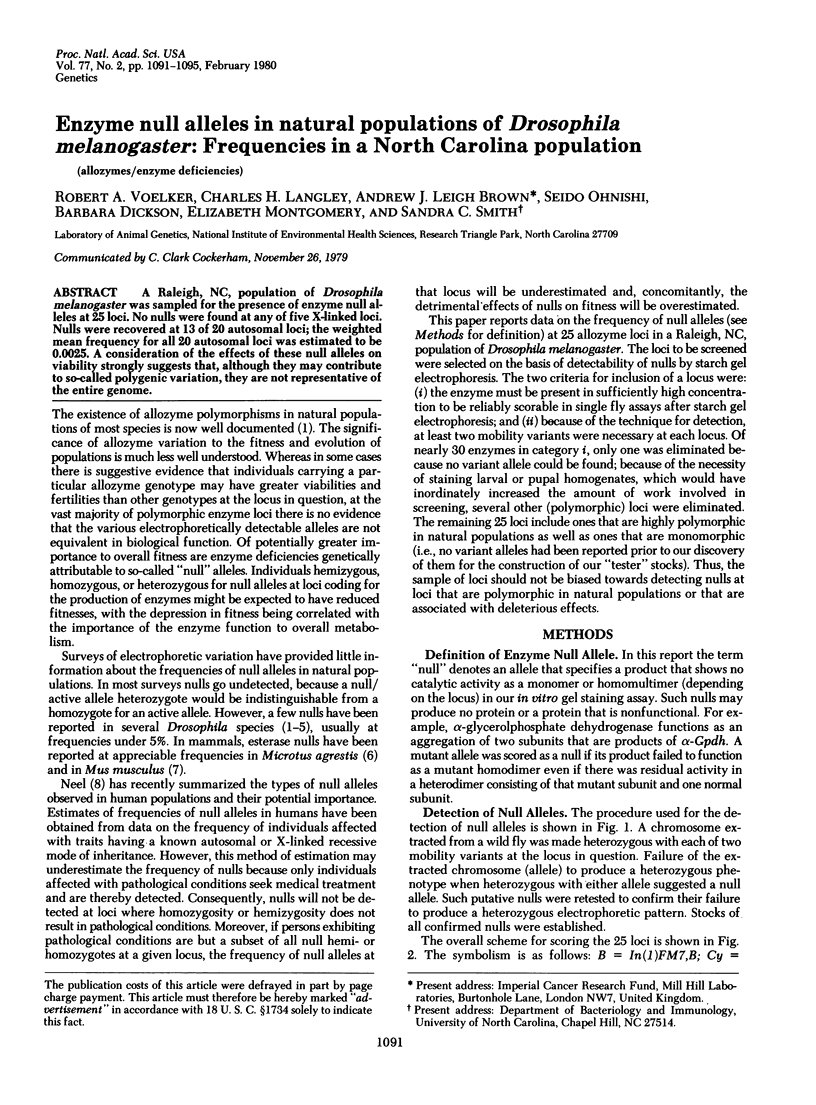
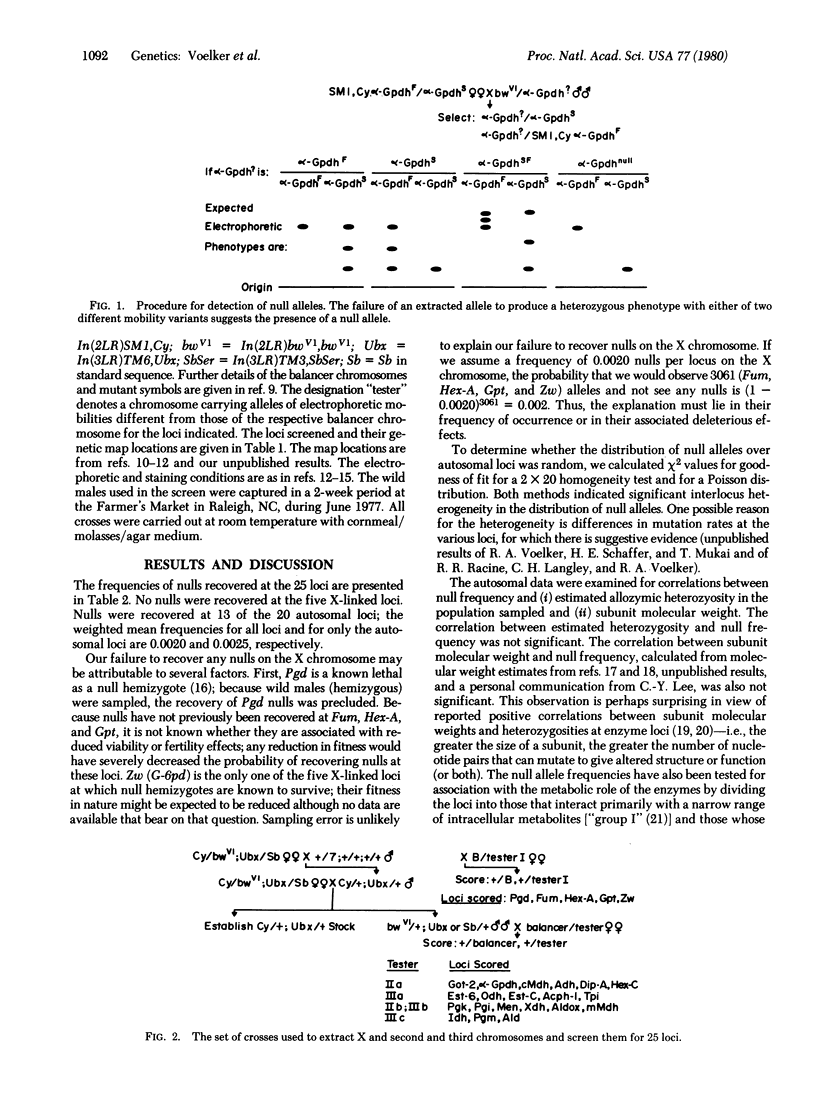
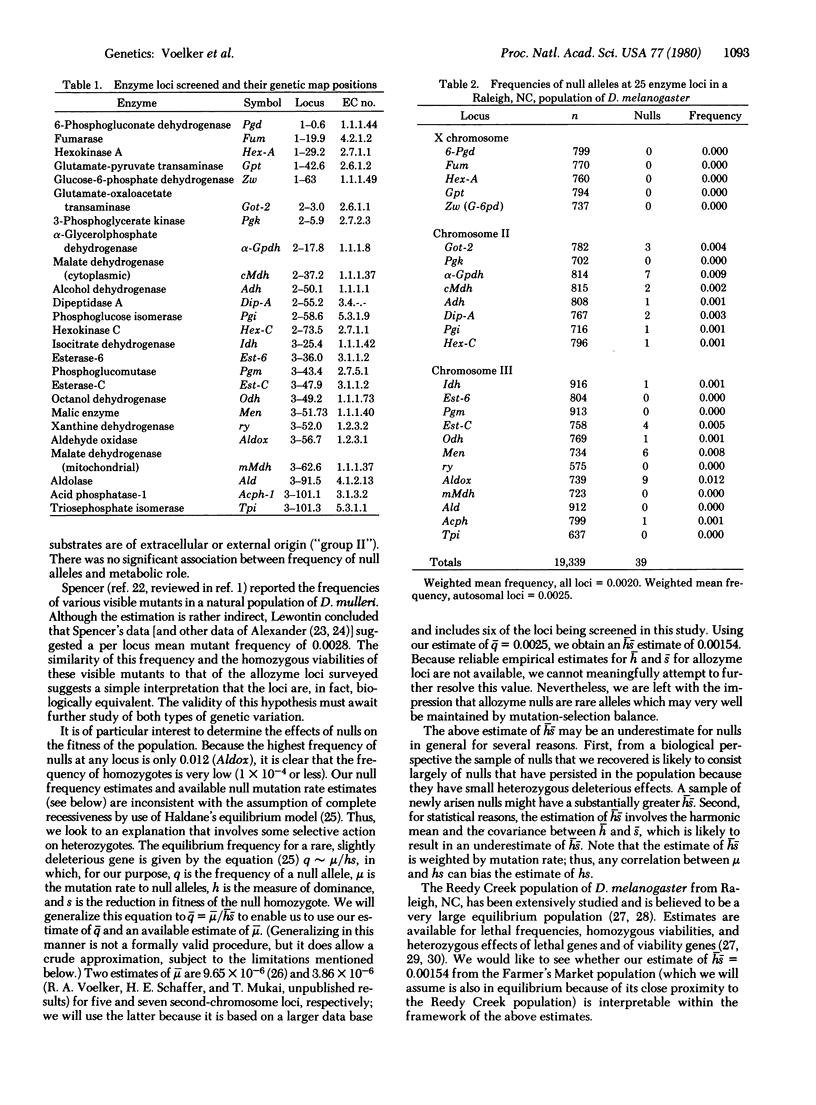
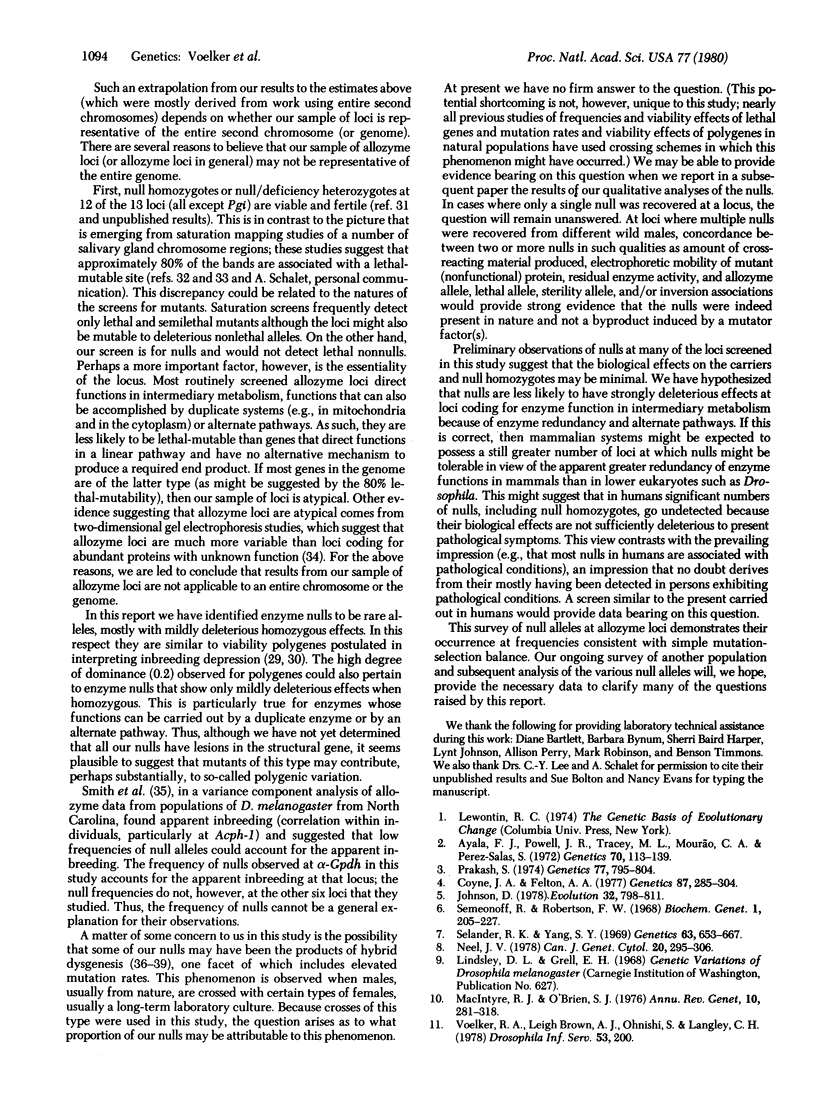
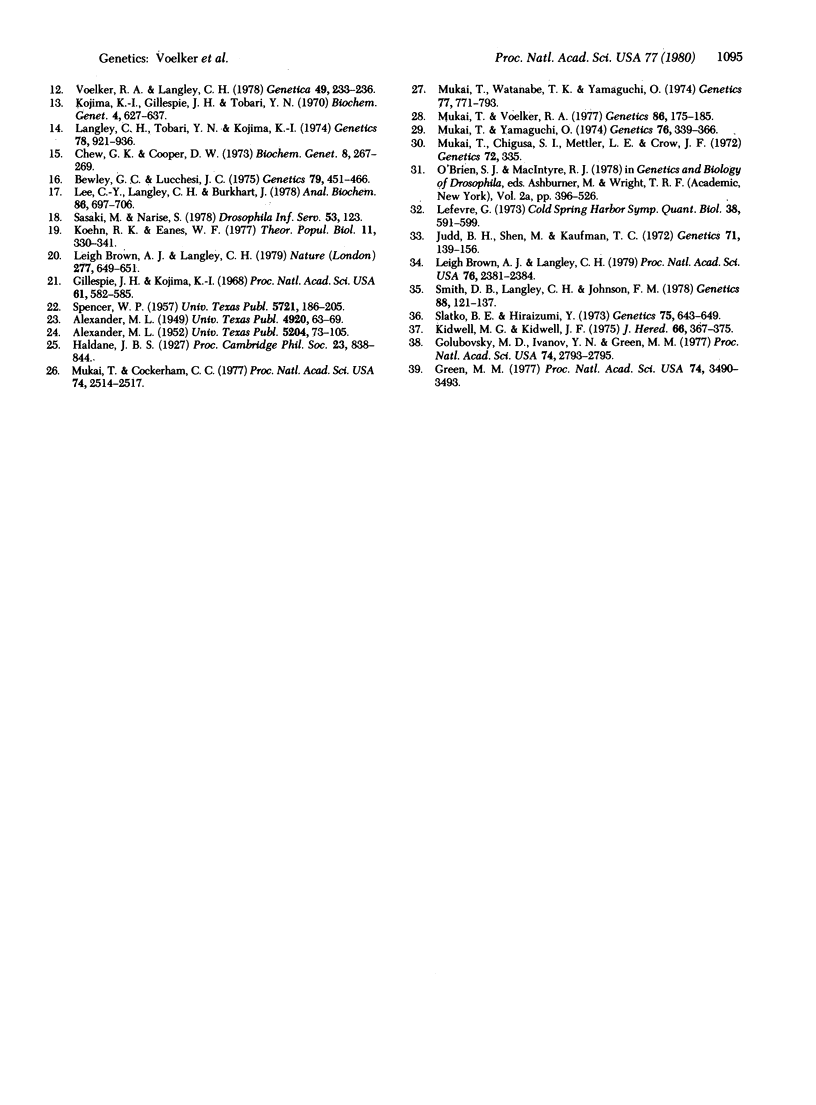
Selected References
These references are in PubMed. This may not be the complete list of references from this article.
- Ayala F. J., Powell J. R., Tracey M. L., Mourão C. A., Pérez-Salas S. Enzyme variability in the Drosophila willistoni group. IV. Genic variation in natural populations of Drosophila willistoni. Genetics. 1972 Jan;70(1):113–139. doi: 10.1093/genetics/70.1.113. [DOI] [PMC free article] [PubMed] [Google Scholar]
- Bewley G. C., Lucchesi J. G. Lethal effects of low and "null" activity alleles of 6-phosphogluconate dehydrogenase in Drosophila melanogaster. Genetics. 1975 Mar;79(3):451–457. doi: 10.1093/genetics/79.3.451. [DOI] [PMC free article] [PubMed] [Google Scholar]
- Brown A. J., Langley C. H. Correlation between heterozygosity and subunit molecular weight. Nature. 1979 Feb 22;277(5698):649–651. doi: 10.1038/277649a0. [DOI] [PubMed] [Google Scholar]
- Brown A. J., Langley C. H. Reevaluation of level of genic heterozygosity in natural population of Drosophila melanogaster by two-dimensional electrophoresis. Proc Natl Acad Sci U S A. 1979 May;76(5):2381–2384. doi: 10.1073/pnas.76.5.2381. [DOI] [PMC free article] [PubMed] [Google Scholar]
- Chew G. K., Cooper D. W. Phosphoglycerate kinas polymorphism in Drosophila. Biochem Genet. 1973 Mar;8(3):267–270. doi: 10.1007/BF00486179. [DOI] [PubMed] [Google Scholar]
- Coyne J. A., Felton A. A. Genic Heterogeneity at Two Alcohol Dehydrogenase Loci in DROSOPHILA PSEUDOOBSCURA and DROSOPHILA PERSIMILIS. Genetics. 1977 Oct;87(2):285–304. doi: 10.1093/genetics/87.2.285. [DOI] [PMC free article] [PubMed] [Google Scholar]
- Gillespie J. H., Kojima K. The degree of polymorphisms in enzymes involved in energy production compared to that in nonspecific enzymes in two Drosophila ananassae populations. Proc Natl Acad Sci U S A. 1968 Oct;61(2):582–585. doi: 10.1073/pnas.61.2.582. [DOI] [PMC free article] [PubMed] [Google Scholar]
- Green M. M. Genetic instability in Drosophila melanogaster: De novo induction of putative insertion mutations. Proc Natl Acad Sci U S A. 1977 Aug;74(8):3490–3493. doi: 10.1073/pnas.74.8.3490. [DOI] [PMC free article] [PubMed] [Google Scholar]
- Judd B. H., Shen M. W., Kaufman T. C. The anatomy and function of a segment of the X chromosome of Drosophila melanogaster. Genetics. 1972 May;71(1):139–156. doi: 10.1093/genetics/71.1.139. [DOI] [PMC free article] [PubMed] [Google Scholar]
- Kidwell M. G., Kidwell J. F. Spontaneous male recombination and mutation in isogenic-derived chromosomes of Drosophila melanogaster. J Hered. 1975 Nov-Dec;66(6):367–375. doi: 10.1093/oxfordjournals.jhered.a108649. [DOI] [PubMed] [Google Scholar]
- Koehn R. K., Eanes W. F. Subunit size and genetic variation of enzymes in natural populations of Drosophila. Theor Popul Biol. 1977 Jun;11(3):330–341. doi: 10.1016/0040-5809(77)90016-8. [DOI] [PubMed] [Google Scholar]
- Kojima K., Gillespie J., Toari Y. N. A profile of Drosophila species' enzymes assayed by electrophoresis. I. Number of alleles, heterozygosities, and linkage disequilibrium in glucose-metabolizing systems and some other enzymes. Biochem Genet. 1970 Oct;4(5):627–637. doi: 10.1007/BF00486100. [DOI] [PubMed] [Google Scholar]
- Langley C. H., Tobari Y. N., Kojima K. I. Linkage disequilibrium in natural populations of Drosophila melanogaster. Genetics. 1974 Nov;78(3):921–936. doi: 10.1093/genetics/78.3.921. [DOI] [PMC free article] [PubMed] [Google Scholar]
- Lee C. Y., Langley C. H., Burkhart J. Purification and molecular weight determination of glucose-6-phosphate dehydrogenase and malic enzyme from mouse and Drosophila. Anal Biochem. 1978 Jun 1;86(2):697–706. doi: 10.1016/0003-2697(78)90797-2. [DOI] [PubMed] [Google Scholar]
- Lefevre G., Jr The one band-one gene hypothesis: evidence from a cytogenetic analysis of mutant and nonmutant rearrangement breadpoints in Drosophila melanogaster. Cold Spring Harb Symp Quant Biol. 1974;38:591–599. doi: 10.1101/sqb.1974.038.01.063. [DOI] [PubMed] [Google Scholar]
- MacIntyre R. J., O'Brien S. J. Interacting gene-enzyme systems in Drosophila. Annu Rev Genet. 1976;10:281–318. doi: 10.1146/annurev.ge.10.120176.001433. [DOI] [PubMed] [Google Scholar]
- Mukai T., Chigusa S. I., Mettler L. E., Crow J. F. Mutation rate and dominance of genes affecting viability in Drosophila melanogaster. Genetics. 1972 Oct;72(2):335–355. doi: 10.1093/genetics/72.2.335. [DOI] [PMC free article] [PubMed] [Google Scholar]
- Mukai T., Cockerham C. C. Spontaneous mutation rates at enzyme loci in Drosophila melanogaster. Proc Natl Acad Sci U S A. 1977 Jun;74(6):2514–2517. doi: 10.1073/pnas.74.6.2514. [DOI] [PMC free article] [PubMed] [Google Scholar]
- Mukai T., Voelker R. A. The genetic structure of natural populations of Drosophila melanogaster XIII. Further studies on linkage disequilibrium. Genetics. 1977 May;86(1):175–185. doi: 10.1093/genetics/86.1.175. [DOI] [PMC free article] [PubMed] [Google Scholar]
- Mukai T., Yamaguchi O. The genetic structure of natural populations of Drosophila melanogaster. XI. Genetic variability in a local population. Genetics. 1974 Feb;76(2):339–366. doi: 10.1093/genetics/76.2.339. [DOI] [PMC free article] [PubMed] [Google Scholar]
- Muki T., Watanabe T. K., Yamaguchi O. The genetic structure of natural populations of Drosophila melanogaster. XII. Linkage disequilibrium in a large local population. Genetics. 1974 Aug;77(4):771–793. doi: 10.1093/genetics/77.4.771. [DOI] [PMC free article] [PubMed] [Google Scholar]
- Neel J. V. Mutation and disease in man. Can J Genet Cytol. 1978 Sep;20(3):295–306. doi: 10.1139/g78-033. [DOI] [PubMed] [Google Scholar]
- Prakash S. Gene differences between the sex ratio and standard gene arrangements of the X chromosome and linkage disequilibrium between loci in the standard gene Drosophila pseudoobscura. Genetics. 1974 Aug;77(4):795–804. doi: 10.1093/genetics/77.4.795. [DOI] [PMC free article] [PubMed] [Google Scholar]
- Selander R. K., Yang S. Y. Protein polymorphism and genic heterozygosity in a wild population of the house mouse (Mus musculus). Genetics. 1969 Nov;63(3):653–667. doi: 10.1093/genetics/63.3.653. [DOI] [PMC free article] [PubMed] [Google Scholar]
- Semeonoff R., Robertson F. W. A biochemical and ecological study of plasma esterase polymorphism in natural populations of the field vole, Microtus agrestis L. Biochem Genet. 1968 Jan;1(3):205–227. doi: 10.1007/BF00485177. [DOI] [PubMed] [Google Scholar]
- Slatko B. E., Hiraizumi Y. Mutation induction in the male recombination strains of Drosophila melanogaster. Genetics. 1973 Dec;75(4):643–649. doi: 10.1093/genetics/75.4.643. [DOI] [PMC free article] [PubMed] [Google Scholar]
- Smith D. B., Langley C. H., Johnson F. M. Variance component analysis of allozyme frequency data from eastern populations of Drosophila melanogaster. Genetics. 1978 Jan;88(1):121–137. doi: 10.1093/genetics/88.1.121. [DOI] [PMC free article] [PubMed] [Google Scholar]


